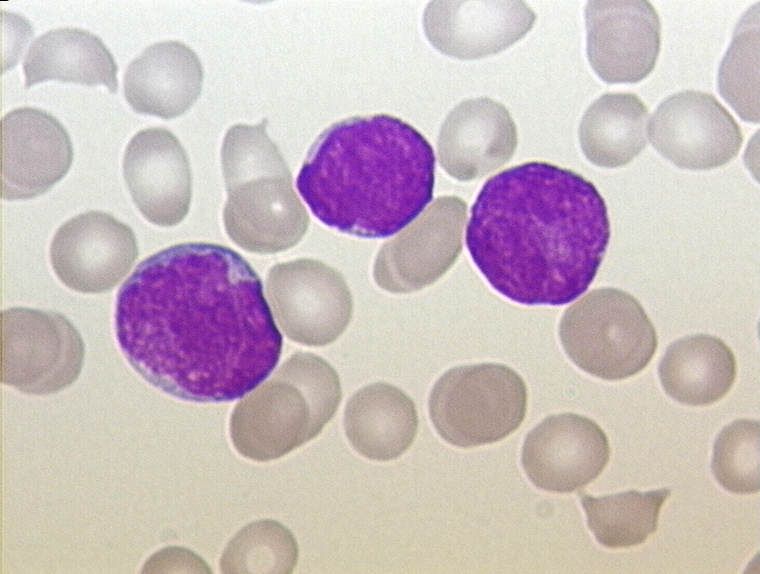Ponatinib Combo Demonstrates Superiority Vs Imatinib in Ph+ Leukemia Subtype
An expert from the University of Texas MD Anderson Cancer Center says that ponatinib plus reduced-intensity chemotherapy may be a new standard of care for frontline Philadelphia chromosome–positive acute lymphoblastic leukemia.
First-line treatment with ponatinib (Iclusig) plus reduced-intensity chemotherapy yielded superior efficacy and was well-tolerated vs imatinib (Gleevec) in patients with Philadelphia chromosome (Ph)–positive acute lymphoblastic leukemia (ALL), according to a presentation on data from the phase 3 PhALLCON trial (NCT03589326) during the February American Society of Clinical Oncology Plenary Series.
"[Considered] together for this patient population, the efficacy and safety results demonstrate a favorable benefit/risk assessment for ponatinib and should be considered a standard of care for frontline therapy in patients with newly diagnosed Ph-positive ALL," according to an expert from the University of Texas MD Anderson Cancer Center.

The study met its primary end point of minimal residual disease (MRD)–negative complete response (CR) of 0.01% BCR::ABL1 or for 4 weeks or more. At the end of induction, the rate of MRD-negative CR was 34.4% in the ponatinib arm (n = 154) vs 16.7% in the imatinib arm (n = 78; relative risk [RR], 2.06; 95% CI, 1.19-3.56; P = .0021).
Additionally, the MRD-negativity rate at the end of induction was 41.6% vs 20.5% in the ponatinib and imatinib arms, respectively (RR, 1.94; 95% CI, 1.19-3.17; P = .0017).
“[Considered] together for this patient population, the efficacy and safety results demonstrate a favorable benefit/risk assessment for ponatinib and should be considered a standard of care for frontline therapy in patients with newly diagnosed Ph-positive ALL,” lead author, Elias Jabbour, MD, professor of medicine in the Department of Leukemia at the University of Texas MD Anderson Cancer Center, said in a presentation on the findings.
Patients were randomized 2:1 to either the ponatinib plus reduced-intensity chemotherapy arm, wherein they were given a starting dose of 30 mg once daily with dose reductions to 15 mg, or a starting dose of imatinib at 600 mg daily plus reduced-intensity chemotherapy.
Additional secondary end points included event-free survival (EFS), molecular response rates, duration of MRD-negative CR, and safety. The median follow-up in the ponatinib arm was 20.4 months vs 18.1 months in the imatinib arm.
“The primary end point of this study differed from what is usually used in routine practice. In our study, patients had to meet 2 clinical end points. This criterion needed to be met at the end of induction,” Jabbour said.
A total or 37% of patients in both arms were 60 years or older. Moreover, 45% vs 47% were male and 96% vs 94% had an ECOG performance status of 0 or 1 between the ponatinib vs imatinib arms, respectively.
A total of 56% vs 64% and 28% vs 33% of patients in each respective arm had 1 or more and 2 or more cardiovascular comorbidities at baseline.
By study cutoff, 41% of patients in the ponatinib arm continued to receive treatment vs 12% in the imatinib arm. Treatment was discontinued in 58% of patients from the ponatinib arm and 86% in the imatinib arm, while the study was discontinuation in 18% vs 22%, respectively.
Treatment was primarily discontinued in each respective arm due to lack of efficacy (7% vs 26%) and adverse effects (AEs; 12% vs 12%), while the study was mainly discontinued due to receipt of hematopoietic stem cell transplant at any time (34% vs 48%).
Jabbour noted that ponatinib was associated with higher MRD negativity at any time compared with imatinib. Additionally, a more robust molecular response was observed in the experimental arm vs the control arm at the end of induction and over time.
The duration of MRD negativity in the ponatinib arm was not estimable (NE; 95% CI, 17.0-NE) compared with 20.9 months (95% CI, 10.9-NE) in the imatinib arm. Additionally, the time to treatment failure was NE (95% CI, NE-NE) in the ponatinib arm vs 21.9 months (95% CI, 12.3-NE) in the imatinib arm.
Thirty-five percent and 57% of patients in the ponatinib arm and imatinib arm, respectively, went on to receive a subsequent anti-cancer therapy. A total of 37% of patients discontinued imatinib and went on to receive either a second or third-generation Tyrosine kinase inhibitor or immunotherapy compared with 19% in the ponatinib arm. Of these patients, 16% had received ponatinib.
EFS in the ponatinib arm was NE (95% CI, NE-NE) vs 29.0 months (95% CI, 22.9-NE) in the imatinib arm (Hazard ratio [HR], 0.65; 95% CI, 0.39-1.10). The progression-free survival was 20.0 months (95% CI, 11.8-NE) vs 7.9 months (95% CI, 6.2-12.4) in each respective arm (HR, 0.58; 95% CI, 0.41-0.83). Moreover, overall survival data remained immature at cutoff, and the median was not reached in either arm (HR, 0.76; 95% CI, 0.38-1.52).
Frequent high-grade nonhematologic treatment-emergent AEs (TEAEs) included hypokalemia (6% vs 19%), lipase increase (13% vs 19%), alanine transferase increase (19% vs 9%), and nausea (3% vs 7%) between the ponatinib vs imatinib arms, respectively.
Common hematologic TEAEs in each respective arm were decreased platelet count (63% vs 58%), decreased white blood cell count (53% vs 49%), decreased lymphocyte count (38% vs 47%), and decreased neutrophil count (49% vs 46%).
Grade 3/4 TEAEs occurred in 90% of patients in the ponatinib arm vs 93% in the imatinib arm, and grade 5 events occurred in 5% each, respectively. Treatment emergent–arterial occlusive events occurred in 2% vs 1%, and treatment emergent–venous thrombotic events occurred in 12% in the ponatinib arm vs 12% in the imatinib arm, respectively. A dose reduction was necessary in 20% of patients in the ponatinib arm vs 22% in the imatinib arm.
Reference
Jabbour E, Kantarjian HM, Aldoss I, et al. First report of PhALLCON: a phase 3 study comparing ponatinib (pon) vs imatinib (im) in newly diagnosed patients with Philadelphia chromosome-positive acute lymphoblastic leukemia (Ph+ALL). J Clin Oncol. 2023;41(suppl 36):398868. doi:10.1200/JCO.2023.41.36_suppl.398868